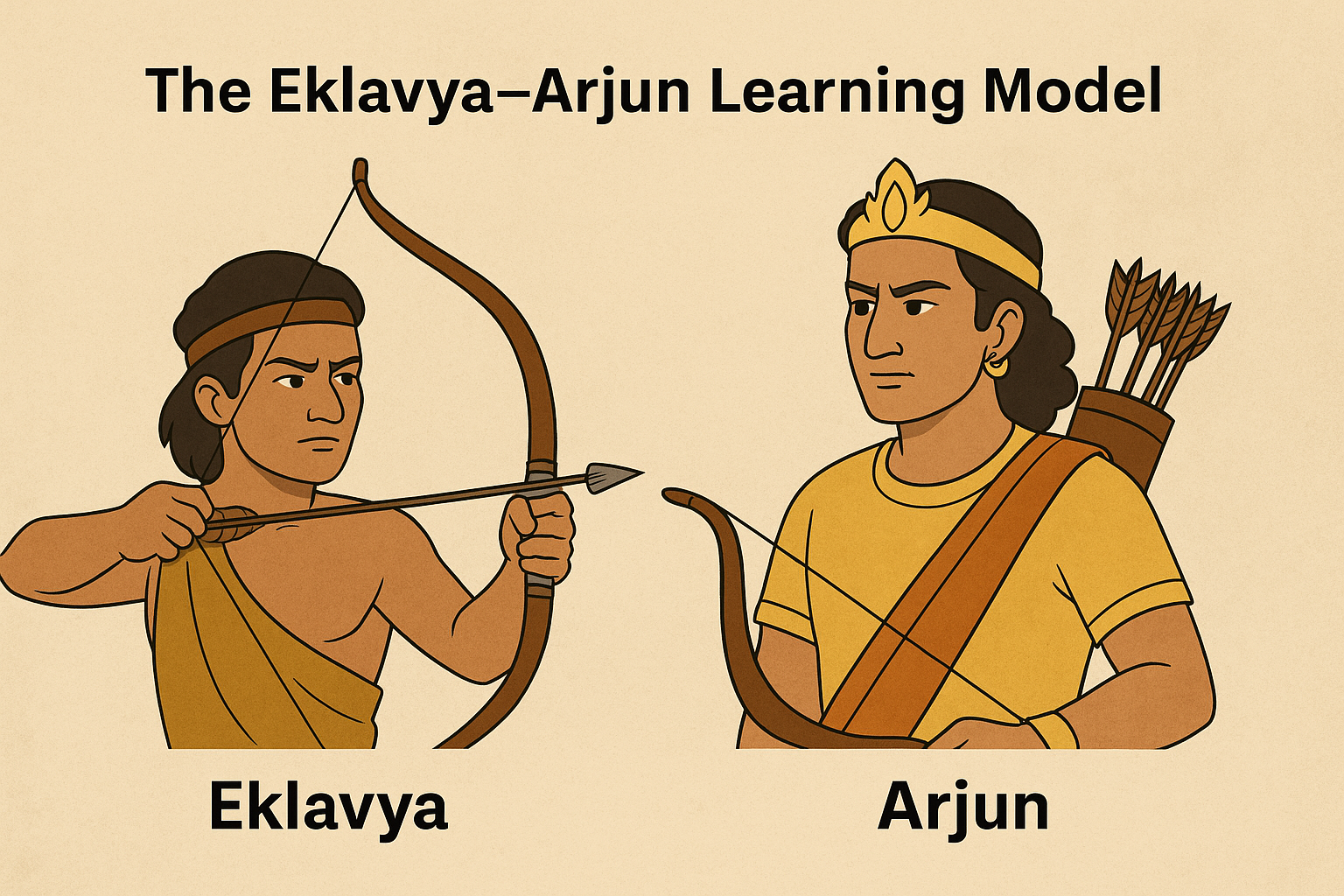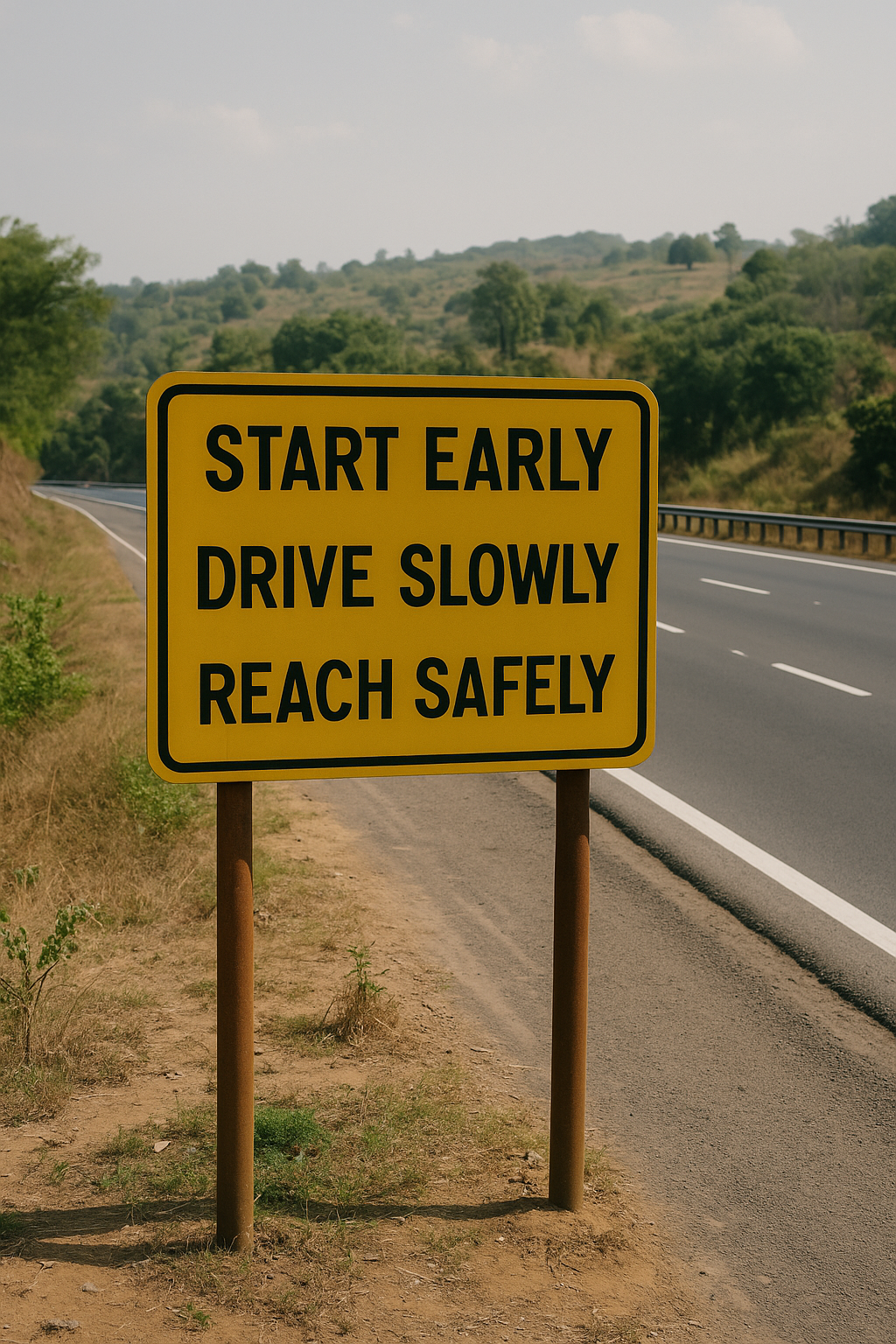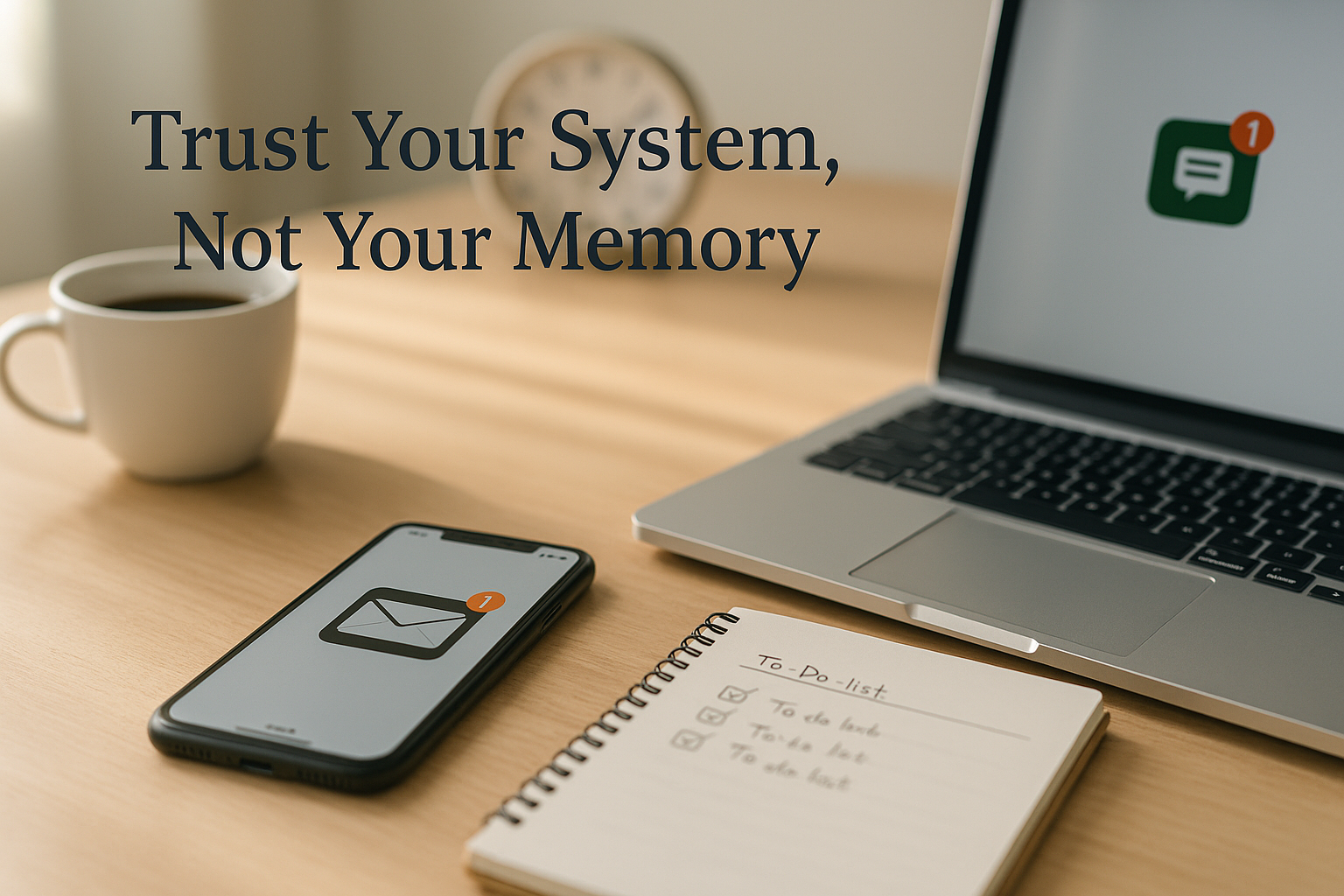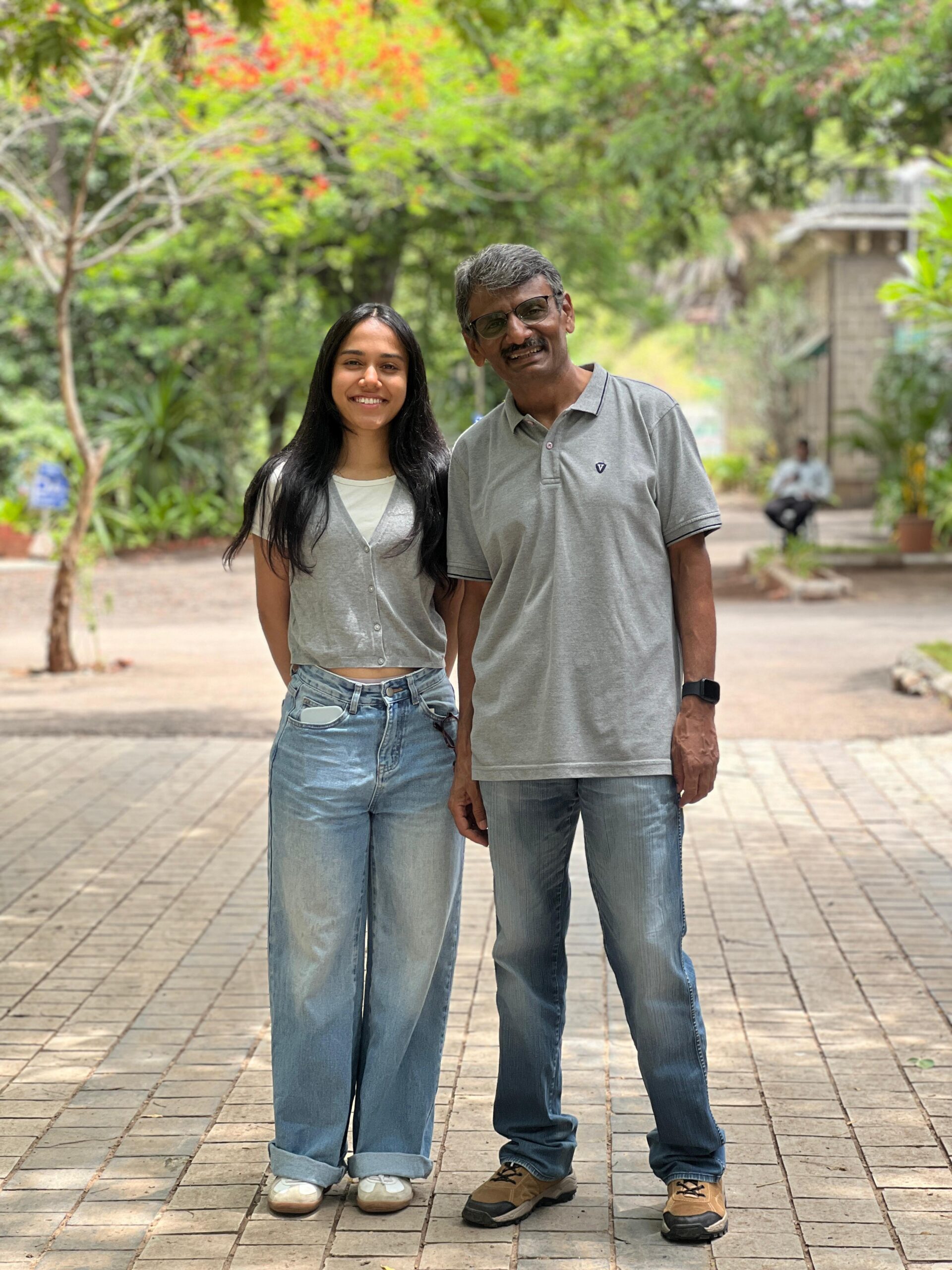The Problem Isn’t Learning — It’s Choosing How to Learn
We all want to learn something new — yoga, singing, strength training, coding, public speaking, tennis, anything. And every time, the same question quietly appears: Should I hire a coach or can I learn this myself?
In today’s world, options multiply faster than clarity. We have YouTube tutorials, recorded MOOCs, online coaches, in-person trainers, group classes, solo practice… and too many reviews to read. Ironically, choosing how to learn now consumes more time and energy than the learning itself.
I’ve wrestled with this too — and eventually found a simple mental model that helps me make faster, more confident decisions. Before I share it, let me start with a small story from my gym.
I used to show up at the gym every morning, almost automatically. For me, consistency was the easy part. But I noticed something interesting. Some of my gym mates wouldn’t come unless their trainer called them personally. Sometimes the trainer made two or three phone calls before the person even arrived. And once they arrived, the coach had to motivate them through every rep, every set — almost the entire workout.
For them, the coach was the accelerator — the reason they showed up at all. For me, the trainer was not about motivation. I never needed someone to push me or “make me come to the gym.” But I did need a trainer to:
- ensure I wasn’t injuring myself
- correct my form
- help me use my effort efficiently
- avoid strength plateaus
My reason for needing a coach was completely different from theirs. That’s when it hit me: We don’t hire coaches for the same reasons. And we don’t need a coach for every skill. This insight connected beautifully with an idea from Indian mythology. In the Indian epic Mahabharata, two iconic archers represent two opposite learning styles:
Eklavya
A self-taught archer with extraordinary determination. He learned in the forest, practicing relentlessly without direct human coaching. His commitment and discipline made him one of the finest archers of his time.
Arjun
A prince and student of the legendary teacher Dronacharya. Arjun benefited from structured coaching, real-time correction, personalized guidance, and a rigorous training environment. He thrived under expert instruction.
Both became exceptional — but through very different learning systems. This inspired what I now call: The Eklavya–Arjun Learning Model – A mental model for deciding when to self-learn and when to hire a coach.
Every skill you want to learn falls into one of two zones.
- The Eklavya Zone — Self-Driven Learning
Choose this path when:
- your motivation is naturally high
- you value flexibility in time and pace
- you love independent exploration
- online resources (YouTube, MOOCs, books) are enough
- cost or availability of a coach is a barrier
- mistakes are low-cost and easily correctable
In this zone, you don’t need a human coach to stay consistent. You already show up — like I did at the gym. This is where self-learning shines. And yes — it often aligns with introverts who enjoy thinking, experimenting and learning alone.
- The Arjun Zone — Coach-Driven Learning
Choose this when:
- you struggle with consistency
- technique, form, or alignment matter
- there is a risk of injury (physical or reputational)
- unlearning mistakes is costly
- real-time correction accelerates progress
- accountability boosts productivity
This is the zone where human coaching multiplies your results. Think of a personal trainer fixing your squat form. Extroverts often flourish here — the human presence energizes and motivates them.
To sum up –
Don’t over-coach your strengths – Self-learn where flexibility matters.
Don’t under-coach your weaknesses – Hire a coach where precision matters.
This one decision alone can save hundreds of hours and thousands of rupees. Both Eklavya and Arjun became masters. The magic lies in identifying your zones with honesty. Neither path is superior. What matters is choosing the right approach for the right skill — at the right moment in your life. This model has saved me time, money, and mental friction. I hope it does the same for you.
Subscribe to my newsletter, to get tips like this and more, directly in your inbox!
(Originally published in Times of India on December 06, 2025)
Consistency Isn’t Magic — It’s Math
A few years ago, a little online puzzle called Wordle unexpectedly became a global ritual. Even if you never played it, you probably saw those green-and-yellow grids everyone kept sharing. The puzzle itself was simple — guess a five‑letter word — but what really hooked people was something even simpler: the streak. The quiet satisfaction of showing up today because you showed up yesterday.
You don’t have to know Wordle to understand this. All of us have felt that pull at some point — the gentle push to continue something just because we’ve been at it for a few days in a row. Once you notice that, you start seeing the same pattern everywhere.
So many things in life stay alive not because they’re easy or exciting every day, but because a streak quietly pulls us forward. A streak makes progress visible. And once progress is visible, we’re reluctant to break it.
I’ve experienced this in my own life in surprisingly small ways. For a while, a friend and I used to share our daily LinkedIn puzzle results. It was a tiny ritual — solve, screenshot, share. Then one day, we simply stopped sending them. A few days later, I checked in on her, and she admitted she had stopped playing altogether. The streak had broken, and with it, the habit quietly dissolved.
A similar pattern showed up when my two brothers and I decided to meditate daily. We had agreed to share a quick update in our WhatsApp group — just a simple “done” whenever each of us finished. For a while, that tiny act kept all three of us consistent. Then one day, we thought it was okay to stop sharing. A few days later, we realised all of us had stopped meditating as well. The streak had vanished, and the routine quietly disappeared. Later, when we spoke about it, we agreed the practice was valuable, so we chose to restart it — this time with a little more care in how we keep the streak alive.
In my own work and practice, I’ve learned to distinguish between maintaining a streak and sharing a streak. Maintaining a streak — even if it’s visible only to you — is the real engine. It’s what builds momentum. Sharing it is optional. It can add a layer of accountability if you have someone to share with, but it’s a bonus, not the foundation.
I’ve also seen how beautifully this idea fits inside a simple productivity journal. You don’t need fancy trackers or habit apps. All you need is a visible count — something that tells your brain, “Look, you’re showing up.”
Record the days you do something — a good habit you want to build. Record the days since you stopped something — a habit you want to break. That visible number turns effort into momentum. And without that count, you may not even realise how consistently you were showing up — there’s no reward, no marker, nothing to acknowledge the effort. And realistically, how could you expect a reward for every single routine action?
I once suggested this to friends who were trying to quit smoking. They started counting smoke-free days — one, then two, then ten. And after a while, that number itself became motivation. None of them wanted to reset the count back to zero.
The exact same principle applies whether you want to go to the gym, meditate, write your book, or give up late-night snacking. Streaks make the invisible visible. And once visible, progress becomes self-reinforcing.
Here’s a simple way to try this for yourself:
- Keep a daily record. Write one line a day for what you did — or didn’t do.
- Add a count. Start with 1 and keep incrementing. Very soon you’ll have numbers like Exercise – 42, Reading – 18, No sugar – 9, Swimming – 82 — and that growing count becomes its own motivation.
- If you miss a day, just continue. You’re not collecting perfection; you’re building momentum. But if the gap becomes big, restart with 1 — it’s a fresh beginning, not a failure.
You’ll notice something interesting happen: the count begins to pull you forward. Streaks act like a small pat on your own back — a quiet push to keep the number growing and a personal challenge to see how far you can go.
The same psychology that kept millions returning to Wordle each morning can help you stay consistent with what truly matters in your own life.
Once progress becomes visible, discipline feels natural — almost effortless.
Subscribe to my newsletter, to get tips like this and more, directly in your inbox!
(Originally published in Times of India on November 21, 2025)
Photo by Nils Huenerfuerst on Unsplash
Teams Win Only When Plans Meet Follow-Through
Planning is where every successful project begins — and the Gantt chart remains one of the most powerful ways to bring order to complexity. It helps teams see the big picture and keep projects on track. But what happens after the plan is made? That’s where many projects lose momentum — not because the chart failed, but because individual task management did. This post looks at both sides: how visualization tools like Gantt charts drive coordination, and why personal task discipline keeps the whole system moving.
If you’ve ever managed a significant-sized project — say, a construction site, a research study, or a multi-department rollout — you’ve probably encountered a Gantt chart. And once you’ve used one properly, you rarely forget its utility.
A Gantt chart is more than a timeline — it’s a visual language for managing complexity.It allows you to see how a project truly moves — and where it might stall. At a glance, you can understand:
- How tasks are sequenced and where dependencies exist
- Which milestones mark progress along the way
- How resources are distributed — and where they might overload
- How delays in one part affect the whole project
- This visualization transforms complexity into clarity.
It converts what would otherwise be a spreadsheet of chaos into a map of logic — one where every moving part is visible. When you’re orchestrating multiple people, timelines, and constraints, that visual structure isn’t a luxury — it’s survival.
It helps project managers allocate resources effectively, adjust priorities intelligently, and keep everyone aligned to reality rather than assumptions.
Many workplaces use enterprise tools like MS Project, Asana, or Jira to manage these dynamics. But when it comes to personal or small-scale projects, I’m often asked to recommend a tool that’s free or inexpensive, yet practical enough to plan and visualize real work. For such cases, a simpler alternative works wonders.
That’s where GanttProject shines. It’s free, open-source, and beautifully visual. You can define tasks, link dependencies, assign resources, and instantly see how milestones and workloads line up.
For engineers, researchers, or small teams, it provides just enough structure to manage real-world complexity — without the overhead of big project suites. It’s a perfect way to see your project before it starts moving.
That same discipline doesn’t translate well into your personal workday. When it’s just you — at your desk, in meetings, or out on the field — you don’t need dependency mapping; you need clarity of the next action. That’s where the line between project management and personal task management becomes clear.
A Gantt chart gives you the plan view, but execution happens through task flow. And while most organizations train their teams on project tools, few help individuals build effective personal work systems. It’s often left to preference — sticky notes, reminders, scattered apps — until something slips.
And that’s where even well-planned projects lose momentum: not through poor charts, but through unstructured personal execution.
Interestingly, contrary to what many might assume, a personal task system doesn’t have to interfere with individual work preferences. There are several well-known methodologies for task management, each varying in rigor and sophistication — the simplest being the humble to-do list. It’s not rocket science though. Its purpose is simply to anchor people to their current priorities while making it easy to update those priorities and maintain the flexibility to choose tasks.
A Gantt chart ensures collective alignment; a disciplined task system ensures individual reliability. Both are essential layers of productivity — one maps the journey, the other fuels the motion.
Subscribe to my newsletter, to get tips like this and more, directly in your inbox!
(Originally published in Times of India on November 9, 2025)
A simple truth from the road — and from life: start before you have to
You have to send an important email tomorrow — maybe it’s a proposal, an update, or a follow-up. So you tell yourself, “I’ll do it tomorrow.” And technically, you’re right. The sending has to happen tomorrow — which really just means you’ll be pressing the send button then. The preparation, though? That can start right now. Sounds like common sense, doesn’t it? Yet somehow, we miss it more often than we realize.
You could easily draft the email today, let it sit quietly in your drafts folder overnight, and give it a quick look tomorrow before sending it out. You’ll wake up lighter, without that tiny, nagging thought: “Oh, I still have to write that email.” And if you wish to, you might even refine a few lines, soften your tone, or make that one small improvement that comes only after a second look.
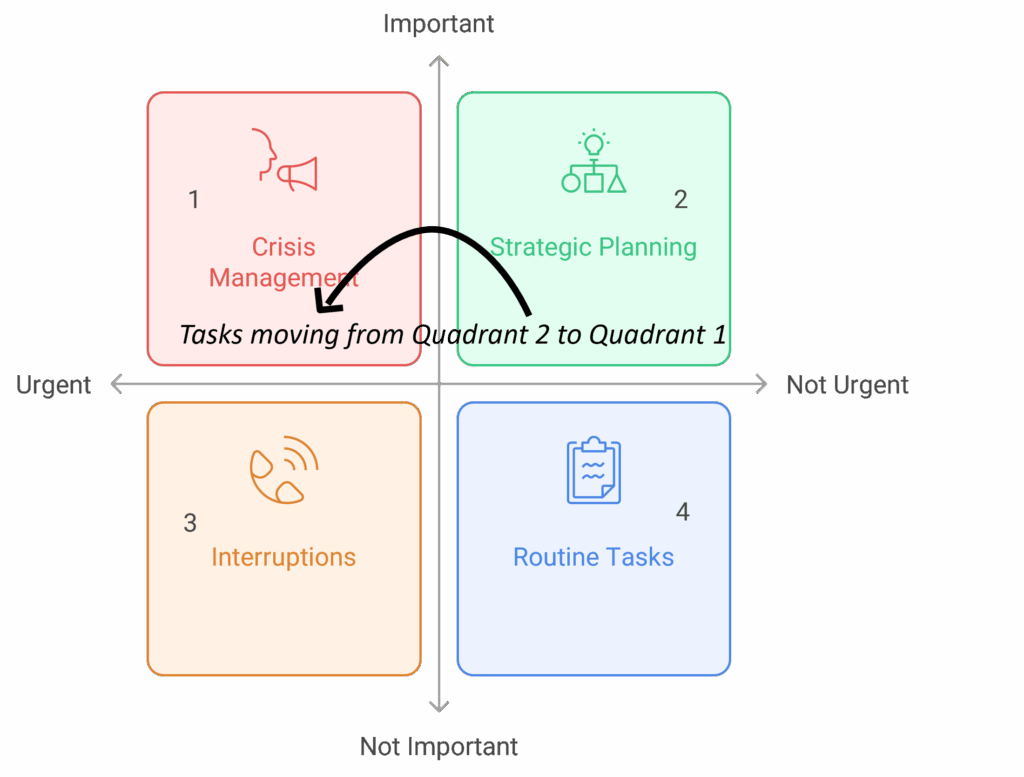 This small act captures something bigger. We often think that unless something is due today, we can wait. But that thinking quietly pushes us from what Eisenhower called Quadrant 2 — important but not urgent — into Quadrant 1, where things become urgent and stressful. And that’s where last-minute tension, rework, and unnecessary anxiety live.
This small act captures something bigger. We often think that unless something is due today, we can wait. But that thinking quietly pushes us from what Eisenhower called Quadrant 2 — important but not urgent — into Quadrant 1, where things become urgent and stressful. And that’s where last-minute tension, rework, and unnecessary anxiety live.
When you start earlier — not just a day before, but as soon as the task appears on your radar — you give yourself space. You see things you might have missed otherwise. You might realise the task is trickier than you expected, that you need more inputs, or that some instruction is unclear. If you discover these only on the day of the deadline, even small tasks can throw your entire schedule off. But when you begin early, you have time to clarify, adjust, and breathe.
Starting early doesn’t mean you have to finish everything right away. It just means crossing that invisible line of getting started. You don’t need to complete the report, record the video, or send the email immediately — but you can draft, outline, or test the first step. Once the ball is rolling, the mind relaxes, and the rest becomes easier.
It’s not about working faster; it’s about working sooner. Deadlines will always be fixed points in time, but your preparation can stretch around them. People who handle work calmly and consistently aren’t superhuman — they just start before they have to.
Next time you think, “I have to finish that next week,” remind yourself, “Which means I should begin this week.” That’s the essence of it all — start before you have to.
Subscribe to my newsletter, to get tips like this and more, directly in your inbox!
Don’t Miss Important Messages: Trust Your System, Not Your Memory
In today’s global work environment, email and instant messages are the lifeblood of collaboration. On any given day, you might check them from your laptop, tablet, or mobile device — between meetings, during a commute, or while making coffee.
You might glance at a message, instantly understand what’s being asked of you, and think, “I’ll handle this later.” But then the day speeds up. More notifications arrive. By the time you remember that message, it’s buried deep under a growing pile of unread items.
It’s not a question of carelessness — it’s a question of cognitive limits. Our short-term memory can only hold a handful of items at once, and only briefly. As psychologist George A. Miller described in his classic paper, “The Magical Number Seven, Plus or Minus Two,” our minds can typically manage only about five to nine discrete pieces of information at any given time. That means even a single distraction can overwrite what we just read or planned to do. Unless we capture a message somewhere external, it simply fades.
That’s why the discipline of checking messages isn’t enough. You can read every email and still miss something important if it never makes the leap from your mind into a reliable system that remembers for you.
The Discipline of Daily Processing
The antidote to missed messages isn’t another app or reminder — it’s consistent discipline.
Make checking your emails and messages a non-negotiable part of your morning routine.
This isn’t to say you should only check messages in the morning. Of course, you’ll read and respond to them throughout the day — as part of your normal workflow.
The purpose of the morning routine is different: it’s your fail-safe. It’s the daily checkpoint that catches anything you may have missed, forgotten, or left hanging amid the rush of the previous day.
Sometimes you’ll be confident that you’ve already captured every new task or follow-up — but do the drill anyway. You’ll be surprised how often a message, a quick chat, or a small promise slips through unnoticed. Our memory is far less reliable than we’d like to believe.
The keyword here is process, not respond.
You don’t need to execute every task immediately. The goal is to recognize, decide, and record each actionable message into your trusted system — your to-do list, task manager, or follow-up tracker.
If something takes less than two minutes, feel free to complete it right away. But for everything else, your mission is simple: get it out of your head and into your system.
Please note, when you do this every day, you’re only processing messages from the last 24 hours. Most apps even label them as “yesterday”, making it easy to spot and clear anything that arrived since your last check. It’s a light lift — a daily reset that keeps your system current and trustworthy.
The Trap: Don’t Run With the First “Important” Task
During this message review, you’ll often come across a task that feels urgent, exciting, or personally meaningful. The temptation is to drop everything and start on it immediately.
Resist that urge.
When you dive into one task before finishing your review, the rest of your messages remain unprocessed — which means hidden risks and unfinished requests still lurk in your inbox. You lose visibility before you’ve even begun.
Treat this step like triage: finish the scan, then decide what truly deserves your attention next.
This simple act separates reactive busyness from intentional productivity.
Conclusion: Trust Your System, Not Your Memory
Our minds aren’t built to hold dozens of digital threads at once. Important messages slip not because we’re inattentive, but because we rely on a system — short-term memory — that isn’t made for this world of endless input.
True productivity comes from trusting your system, not your memory. When you build the daily habit of message processing, you’re not just tidying your inbox — you’re designing reliability into your day.
It’s a quiet form of professionalism: ensuring that nothing meaningful depends on chance or recall.
And the result?
Peace of mind, clearer focus, and the confidence that every message — and every responsibility — is exactly where it should be.
Subscribe to my newsletter, to get tips like this and more, directly in your inbox!
(Originally published in Times of India on October 10, 2025)
The Counterintuitive Truth About Time Management
At first glance, certain uses of time look unproductive. But if you zoom out, they often turn out to be among the wisest investments you can make.
Breaks That Push You Forward
Consider breaks. Stepping back from a problem can feel like stalling. Yet how many times has clarity struck you after a pause—a walk, a cup of tea, even a shower? The act of stepping away often reveals the direction that sheer persistence could not. This connects right back to our opening idea: what looks like lost time is often a smart investment in disguise.
The same is true at work. Frequent restorative breaks—drinking water, strolling a bit, stretching at your desk—are not distractions. They reduce stress, give your body a metabolic nudge, and sustain the very focus you depend on for deep work.
As Edwin C. Bliss rightly put it:
“Anything that contributes to health is good time management.”
Sprinting at breakneck speed can feel productive in the moment, but if it leads to burnout, illness, or lifestyle diseases, your multi‑year output collapses. Investing in health—through pauses, movement, sleep, and nutrition—may look like a time cost today, yet over a larger time frame it becomes a compounding productivity asset.
People: The Most “Unproductive” Yet Most Valuable Use of Time
Another area where this counterintuitive principle shines is in relationships. Spending time with people doesn’t always feel efficient. The activity might not advance your goals, and conversations may drift away from work altogether. Yet, people are almost always a good use of time.
I’ve experienced this firsthand during my evening walks. For years, I’ve used them to push forward my reading habit—listening to audiobooks on Kindle and Audible while walking or on the treadmill. But many times, my daughter, my wife, or even one of my neighbor friends joins me. When they do, I don’t hesitate to pause the audio. The chats we share may not move my reading list forward, but they strengthen bonds that matter far more in the long run. Just like health, relationships demand steady, ongoing investment.
The Bigger Picture
Here’s the real counterintuitive twist: many people equate setting up a formal time management system with squeezing in more work. It’s not. When you manage your time appropriately, you gain control over your work. That control gives you the freedom to pace yourself, reduce stress, and remain flexible enough to seize serendipitous opportunities when they arise.
Breaks and people may look like inefficiencies on the surface. In truth, they’re pillars of sustainable productivity. Time management, at its best, isn’t about doing more. It’s about living better by having control on our time usage.
Subscribe to my newsletter, to get tips like this and more, directly in your inbox!
(Originally published in Times of India on September 27, 2025)


